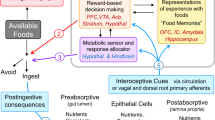Abstract
Fenfluramine, a clinically used anorectic agent, is known to act as a potent unconditioned stimulus in the establishment of a conditioned flavour aversion (CFA). Here we demonstrate that dl-fenfluramine supports the development of a CFA to a novel flavour when drug administration precedes the CS (reverse pairing), although several such UCS/flavour pairings are required under our conditions. In this situation, because fenfluramine exerts a strong anorectic effect, the animals drink little of the flavoured solutions. Artificial reduction of the volume of solutions drunk during conditioning also had no effect on the magnitude of the aversion with either forward or reverse pairings of the UCS and CS. These results suggest an alternative explanation to the idea that a fenfluramine-induced CFA arises as a secondary consequence of delayed stomach emptying.
Similar content being viewed by others
References
Bond N, DiGiusto E (1975) Amount of solution drunk is a factor in the establishment of taste aversion. Anim Learn Behav 3:81–84
Booth DA, Pilcher CWT, D'Mello GD, Stolerman IP (1977) Comparative potencies of amphetamine and related compounds in taste aversion experiments in rats. Br J Pharmacol 61:669–677
Bouton ME, King DA (1986) Effect of context on performance to conditioned stimuli with mixed histories of reinforcement and nonreinforcement. J Exp Psychol 12:4–15
Carlton PL, Wolgin DL (1971) Contingent tolerance to the anorectic effects of amphetamine. Physiol Behav 7:221–223
Davies RF, Rossi JR, Panksepp J, Bean NJ, Zolovick AJ (1983) Fenfluramine anorexia: a peripheral locus of action. Physiol Behav 30:723–730
Deutsch JA (1983) Dietary control and the stomach. Prog Neurobiol 20:313–332
Fletcher PJ, Burton MJ (1984) Effects of manipulations of peripheral serotonin on feeding and drinking in the rat. Pharmacol Biochem Behav 20:835–840
Gamzu E, Vincent G, Boff E (1985) A pharmacological perspective of drugs used in establishing conditioned taste aversions. Ann NY Acad Sci 443:231–249
Kirk RE (1982) Experimental design: procedures for the behavioral sciences. Brooks/Cole, Monterey
Lorden JF, Callahan M, Dawson R (1979) Effects of forebrain serotonin depletion on fenfluramine-induced taste aversions. Physiol Psychol 7:97–101
Mackintosh NJ (1974) The psychology of animal learning. Academic Press, New York
Mackintosh NJ (1983) Conditioning and associative learning. Cambridge University Press, Cambridge
Rowland NE, Carlton J (1986) Neurobiology of an anorectic drug: Fenfluramine. Prog Neurobiol 27:13–62
Simson PC, Booth DA (1973) Effect of CS-UCS interval on the conditioning of odour preferences by amino acid loads. Physiol Behav 11:801–808
Westbrook RF, Brookes N (1988) Potentiation and blocking of conditioned flavour and context aversions. Q J Exp Psychol 40B:3–30
Author information
Authors and Affiliations
Rights and permissions
About this article
Cite this article
Barnfield, A.M.C., Clifton, P.G. Flavour aversions conditioned by dl-fenfluramine: a volume independent mechanism. Psychopharmacology 98, 108–112 (1989). https://doi.org/10.1007/BF00442015
Received:
Accepted:
Issue Date:
DOI: https://doi.org/10.1007/BF00442015




